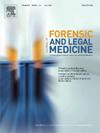在瑞士法医尸体解剖案例中,人体测量体重估计的准确性低于目测体重估计的准确性。
IF 1.2
4区 医学
Q3 MEDICINE, LEGAL
引用次数: 0
摘要
当必须计算死亡时间时,法医病理学家通常会考虑根据亨斯格提名图进行计算。这种计算方法需要估计体重。以往的研究表明,医护人员对病人体重的猜测通常不准确。近年来,基于人体测量参数(如中臂围或腰围)的体重估算方法已被证明可提高估算的准确性。本研究旨在探讨在法医病理学中,与目测法相比,人体测量体重估计方法能否提高体重估计的准确性。在 199 例瑞士人中,我们在解剖前测量了实际体重、中臂围、腰围和身高。此外,两名法医病理学家目测了体重。我们发现中臂围与实际体重的相关性最强(Pearson 'sr 0.87, 95 % CI 0.83-0.90)。然而,所有基于中臂围度的估算方法都比之前描述的方法表现更差。-12.3%到-14.5%之间的统计偏差表明存在系统性的体重低估。在我们的研究人群中,两位医生的联合目测估算结果明显优于人体测量方法,但与之前文献中描述的人体测量估算方法没有区别。对于目前还不适用于全球人口的新型体重估算方法,还需要进一步研究。本文章由计算机程序翻译,如有差异,请以英文原文为准。
Anthropometric weight estimation is less accurate than visual weight estimation in forensic postmortem cases in a Swiss population
When the time since death must be calculated forensic pathologists often consider a calculation based on the Henssge nomogram. This calculation requires an estimated body weight. Previous research has indicated that healthcare workers generally inaccurately guessed patients’ body weights. In recent years, weight estimation methods based on anthropometric parameters, such as mid-arm or waist circumference, have been shown to improve estimation accuracy. This study aimed to examine whether anthropometric weight estimation methods could improve weight estimation accuracy compared to visual estimation in forensic pathology.
In 199 cases from a Swiss population, we measured the actual body weight, mid-arm circumference, waist circumference, and body height before autopsy. Additionally, two forensic pathologists visually estimated the body weight. We found mid-arm circumferences to correlate the strongest with actual body weight (Pearson ’sr 0.87, 95 % CI 0.83–0.90). However, all mid-arm circumference-based estimation methods performed worse than those previously described. A statistical bias between −12.3 % and −14.5 % indicated a systematic weight underestimation. Combined two-physician visual estimation performed significantly better than anthropometric measurements in our population but showed no difference from anthropometric estimation methods previously described in the literature. Further research is needed on novel body weight estimation methods that are currently not applicable for the global population.
求助全文
通过发布文献求助,成功后即可免费获取论文全文。
去求助
来源期刊

Journal of forensic and legal medicine
MEDICINE, LEGAL-
CiteScore
2.70
自引率
6.70%
发文量
106
审稿时长
57 days
期刊介绍:
The Journal of Forensic and Legal Medicine publishes topical articles on aspects of forensic and legal medicine. Specifically the Journal supports research that explores the medical principles of care and forensic assessment of individuals, whether adult or child, in contact with the judicial system. It is a fully peer-review hybrid journal with a broad international perspective.
The Journal accepts submissions of original research, review articles, and pertinent case studies, editorials, and commentaries in relevant areas of Forensic and Legal Medicine, Context of Practice, and Education and Training.
The Journal adheres to strict publication ethical guidelines, and actively supports a culture of inclusive and representative publication.
 求助内容:
求助内容: 应助结果提醒方式:
应助结果提醒方式:


